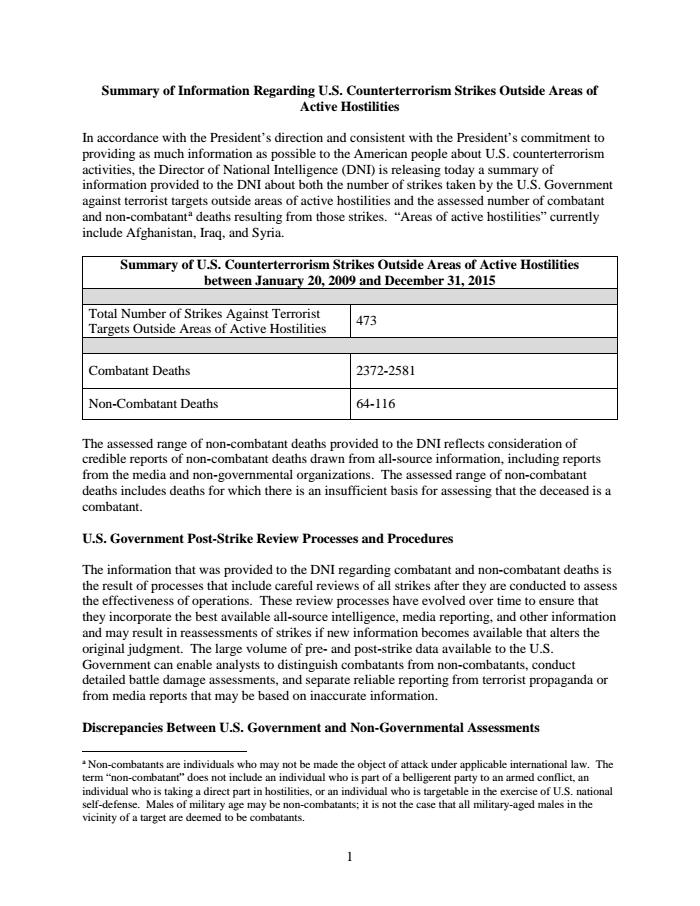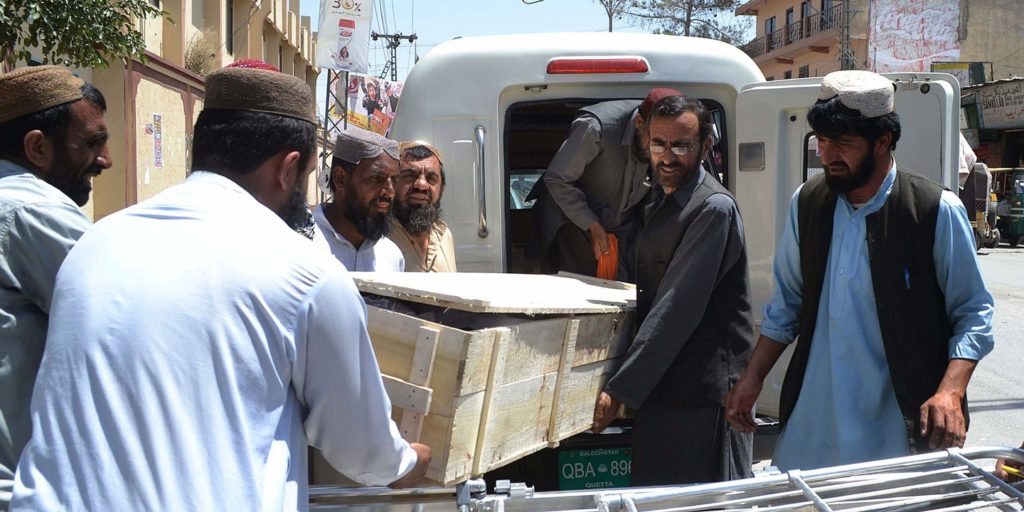Obama Administration Finally Releases Its Dubious Drone Death Toll
ANGLO AMERICA, 4 Jul 2016
Ryan Devereaux – The Intercept
1 Jul 2016 – In a long-anticipated gesture at transparency, the Obama administration on Friday [1 Jul] released an internal assessment of the number of civilians killed by drone strikes in nations where the U.S. is not officially at war.
According to the data, U.S. drone strikes in Pakistan, Yemen, Somalia, and Libya killed between 64 and 116 civilians during the two terms of the Obama administration — a fraction of even the most conservative estimates on drone-related killings catalogued by reporters and researchers over the same period. The government tally also reported 2,372 to 2,581 combatants killed in U.S. airstrikes from January 20, 2009, to December 31, 2015.
Releasing the figures — which appeared on a Friday afternoon, on a holiday weekend, after seven years of selective leaks and official secrecy — along with an executive order prioritizing the protection of civilian life in counterterrorism operations, reflected core American principles, the president asserted.
In addition to mandating an increased emphasis on civilian protection in U.S. tactics and training, the executive order also called on the Office of the Director of National Intelligence to release annual reports on civilian casualties resulting from counterterrorism operations, such as drone strikes, in nations where the U.S. is not at war — a move that, in effect, signals the further institutionalization of borderless wars for the foreseeable future.
“As a nation, we are steadfastly committed to complying with our obligations under the law of armed conflict, including those that address the protection of civilians, such as the fundamental principles of necessity, humanity, distinction, and proportionality,” Obama’s order read.
While many within the legal and human rights communities applauded the voluntary disclosure of casualty data and the executive order as a step in the right direction, some felt the Friday news dump fell short in key areas.
“It’s hard to credit this death count, which is lower than all independent assessments,” Hina Shamsi, the director of the ACLU’s National Security Project, told The Intercept.
Organizations such as the Long War Journal, the New America Foundation, and the Bureau of Investigative Journalism estimate that at least 200 and as many as 1,000 civilians have been killed by American drone strikes in nations where the U.S. is not at war since Obama took office. The administration offered no individualized accounts to explain where its numbers came from, or who the civilian casualties were. Without the government addressing individual cases, disclosing the identities of those killed, or providing detailed information on the investigations undergirding its conclusions, Shamsi contended, little could be done with the disclosures.
“Without key information like this, the public can’t be confident,” she said.
The drone program, as it’s often referred to in press accounts, is in fact a combination of both independent and overlapping efforts overseen by the military and the CIA — with support from other intelligence community agencies such as the NSA — that vary in intensity and management depending on the country. Under Obama, the unmanned vehicles have become both a tool and a symbol of a new age of modern American warfare, one in which the U.S. government asserts the right to reach out and kill suspected terrorists wherever they may be.
The casualty data, presented in the form of a three-page account, claims to reflect “credible reports of non-combatant deaths drawn from all-source information, including reports from the media and non-governmental organizations.” The report acknowledged that discrepancies exist between the government’s tallies and those compiled by NGOs over the last several years.
NGOs provide accounts that differ not only from official figures, but also vary widely from organization to organization, the report said. “For instance, for the period between January 20, 2009, and December 31, 2015, non-governmental organizations’ estimates range from more than 200 to slightly more than 900 possible non-combatant deaths outside areas of active hostilities.”
The government argued, as it has before, that it has access to information — informants and electronic surveillance, for example — that researchers, journalists, and human rights advocates are not privy to.
Yet the government’s means of assessing the efficacy of individual strikes have been called into question in recent years. Informants on the ground for U.S. forces can provide mistaken information, and aerial battle damage assessments, or BDAs — a common tool for assessing drone strikes — have at times proved unreliable. “According to one study in Afghanistan, initial air BDAs failed to identify civilian casualties in 19 out of 21 cases subsequently confirmed by ground force investigations,” noted a report on civilian protection published last month by the Open Society Foundations.
The government’s report also suggested that malign actors can spread misinformation that makes its way into NGO reports, resulting in slain militants being misidentified as civilians, though it offered no specific examples of this taking place.
While the administration’s report was short on details, it did push back on claims that U.S. officials have, over the years, maintained a practice of labeling military-aged males killed in drone strikes as militants unless evidence is produced indicating otherwise. “Males of military age may be non-combatants; it is not the case that all military-aged males in the vicinity of a target are deemed to be combatants,” it said.
The government’s insistence that it does not label dead young men as militants by default contradicted years of reporting from multiple news organizations (just this week, former military and intelligence officials speaking to the Los Angeles Times confirmed that had been a practice under the Obama administration until recently).
In October, The Intercept published The Drone Papers, a series of reports based on classified military documents detailing the inner workings of the Pentagon’s drone operations. The source of the documents, a member of the intelligence community who worked on so-called targeted-killing missions, described how military-aged males, or MAMs, killed in drone strikes are routinely labeled as enemies killed in action, EKIA, unless there is information indicating otherwise.
“If there is no evidence that proves a person killed in a strike was either not a MAM, or was a MAM but not an unlawful enemy combatant, then there is no question,” the source said. “They label them EKIA.”
While the publication of the drone data is unprecedented, its lasting impact remains to be seen. Shamsi, the ACLU attorney, said Obama’s executive order reflected “a positive step” for what has otherwise been a regime of near-total secrecy in matters of life and death, but it’s an order “sprinkled with caveats.”
“It’s important to remember that the next president, whoever that president may be, can revoke this order with a pen stroke,” she said.
 ___________________________________
___________________________________
Ryan Devereaux – ✉ryan.devereaux@theintercept.com
Go to Original – theintercept.com
DISCLAIMER: The statements, views and opinions expressed in pieces republished here are solely those of the authors and do not necessarily represent those of TMS. In accordance with title 17 U.S.C. section 107, this material is distributed without profit to those who have expressed a prior interest in receiving the included information for research and educational purposes. TMS has no affiliation whatsoever with the originator of this article nor is TMS endorsed or sponsored by the originator. “GO TO ORIGINAL” links are provided as a convenience to our readers and allow for verification of authenticity. However, as originating pages are often updated by their originating host sites, the versions posted may not match the versions our readers view when clicking the “GO TO ORIGINAL” links. This site contains copyrighted material the use of which has not always been specifically authorized by the copyright owner. We are making such material available in our efforts to advance understanding of environmental, political, human rights, economic, democracy, scientific, and social justice issues, etc. We believe this constitutes a ‘fair use’ of any such copyrighted material as provided for in section 107 of the US Copyright Law. In accordance with Title 17 U.S.C. Section 107, the material on this site is distributed without profit to those who have expressed a prior interest in receiving the included information for research and educational purposes. For more information go to: http://www.law.cornell.edu/uscode/17/107.shtml. If you wish to use copyrighted material from this site for purposes of your own that go beyond ‘fair use’, you must obtain permission from the copyright owner.
